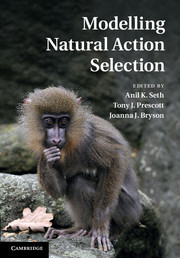Book contents
- Frontmatter
- Contents
- Foreword
- Preface
- Contributors
- 1 General introduction
- Part I Rational and optimal decision making
- Part II Computational neuroscience models
- 9 Introduction to Part II: computational neuroscience models
- 10 Action selection and refinement in subcortical loops through basal ganglia and cerebellum
- 11 Cortical mechanisms of action selection: the affordance competition hypothesis
- 12 Toward an executive without a homunculus: computational models of the prefrontal cortex/basal ganglia system
- 13 Hierarchically organised behaviour and its neural foundations: a reinforcement-learning perspective
- 14 The medial reticular formation: a brainstem substrate for simple action selection?
- 15 Understanding decision-making deficits in neurological conditions: insights from models of natural action selection
- 16 Biologically constrained action selection improves cognitive control in a model of the Stroop task
- 17 Mechanisms of choice in the primate brain: a quick look at positive feedback
- Part III Action selection in social contexts
- Index
- Plate section
- References
9 - Introduction to Part II: computational neuroscience models
from Part II - Computational neuroscience models
Published online by Cambridge University Press: 05 November 2011
- Frontmatter
- Contents
- Foreword
- Preface
- Contributors
- 1 General introduction
- Part I Rational and optimal decision making
- Part II Computational neuroscience models
- 9 Introduction to Part II: computational neuroscience models
- 10 Action selection and refinement in subcortical loops through basal ganglia and cerebellum
- 11 Cortical mechanisms of action selection: the affordance competition hypothesis
- 12 Toward an executive without a homunculus: computational models of the prefrontal cortex/basal ganglia system
- 13 Hierarchically organised behaviour and its neural foundations: a reinforcement-learning perspective
- 14 The medial reticular formation: a brainstem substrate for simple action selection?
- 15 Understanding decision-making deficits in neurological conditions: insights from models of natural action selection
- 16 Biologically constrained action selection improves cognitive control in a model of the Stroop task
- 17 Mechanisms of choice in the primate brain: a quick look at positive feedback
- Part III Action selection in social contexts
- Index
- Plate section
- References
Summary
A central and largely unsolved problem in the brain sciences is to understand the functional architecture of the vertebrate nervous system. Many questions about this architecture revolve around the issue of action selection. Because it is a fundamental property of neurons to be selective with regard to the patterns of input activity to which they respond, claims that particular brain subsystems are specifically or preferentially involved in the selection of action, as distinct to other aspects of control, must meet more stringent requirements (see below). It is also by no means inevitable that the functional decomposition of the brain will contain specialist action-selection mechanisms (see Seth, this volume). Appropriate behavioural switching could be a global property of nervous system function, and of its embedding in a body and environment, that cannot be attributed to specific subcomponents of brain architecture. In other words, it is plausible that an animal may ‘flip’ from one integrated pattern of behavioural output to another without some identifiable internal ‘switch’ being thrown. On the other hand, theoretical arguments can be presented, based for instance on the benefits that accrue from modularity (Bryson, 2005; Prescott et al., 1999; Wagner and Altenberg, 1996), to suggest that biological control systems may include specialised action-selection components. Hence, one important debate in this field is whether there are specialised mechanisms for action selection in animal nervous systems, and, if so, where these might be found (see also Prescott, 2007, for an evolutionary perspective on this question).
Neural substrates for action selection in cortico-basal ganglia loops
Redgrave et al. (1999) have proposed that, to be considered as a candidate action-selection mechanism, a neural subsystem should exhibit the following properties. First, it should have inputs that carry information about both internal and external cues relevant to decision making. Second, there should be some internal mechanism that allows calculation of the urgency or ‘salience’ that should be attached to each available action. Third, there should be mechanisms that allow for the resolution of conflicts between competing actions based on their relative salience. Finally, the outputs of the system should be configured so as to allow the expression of winning actions whilst disallowing losers. There is now a growing consensus in the neuroscience literature that the basal ganglia – a group of functionally related structures found in the mid- and forebrain of all vertebrates – meet these criteria and therefore may represent an important neural action-selection substrate.
Information
- Type
- Chapter
- Information
- Modelling Natural Action Selection , pp. 169 - 175Publisher: Cambridge University PressPrint publication year: 2011
